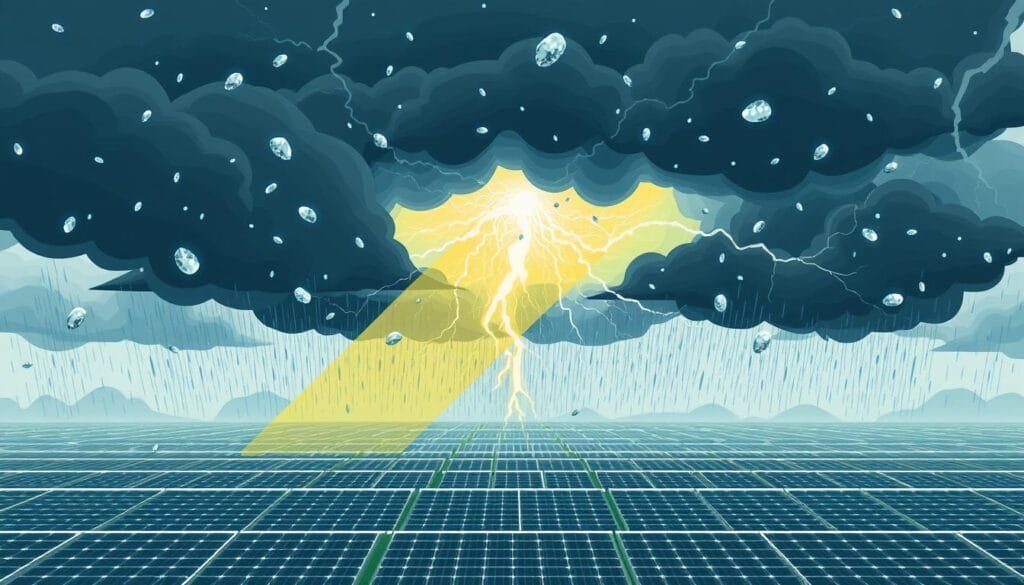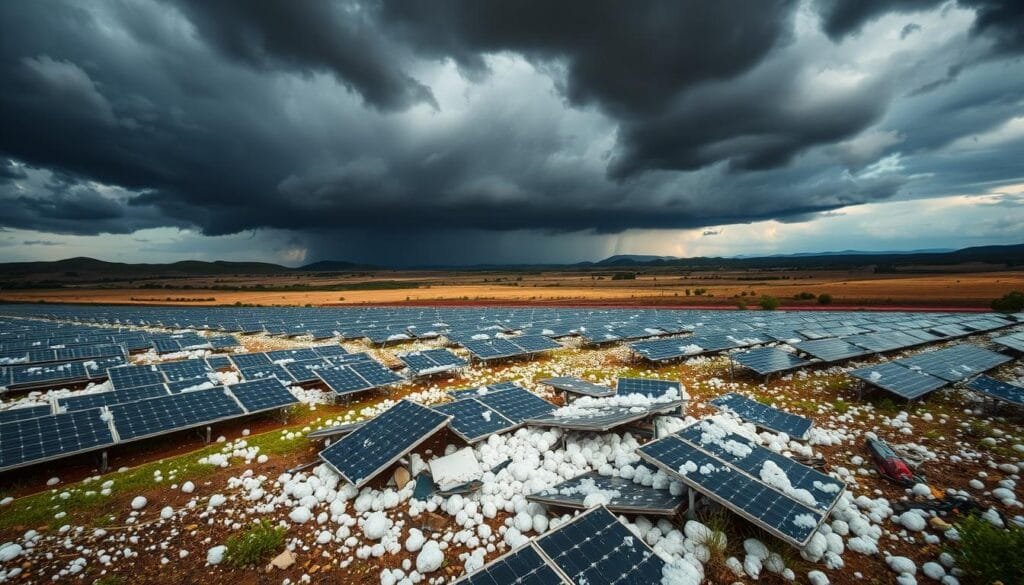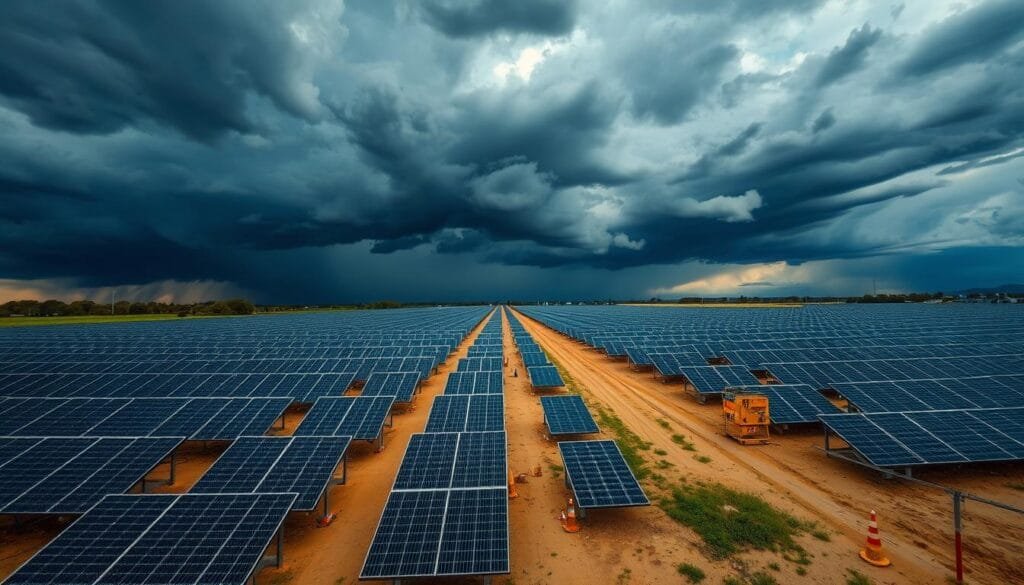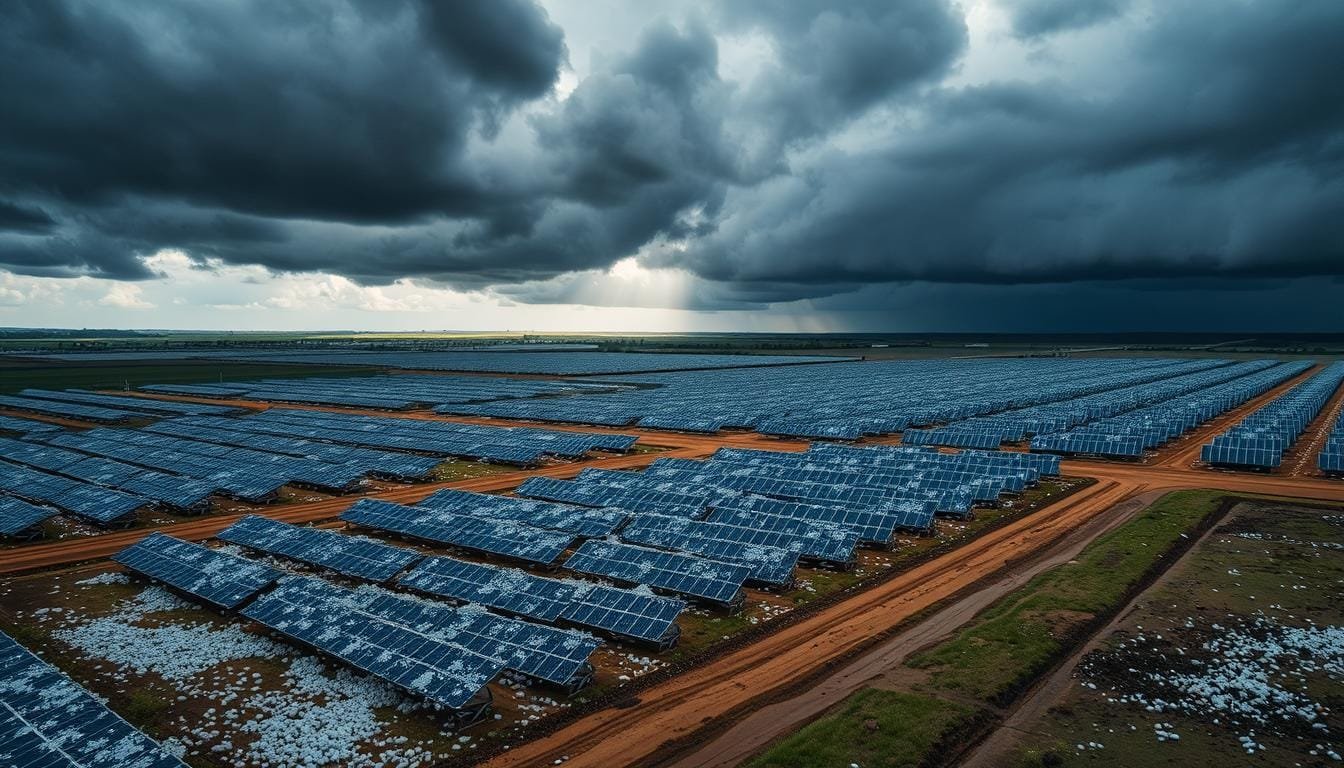A massive hailstorm on March 15 hit the Fighting Jays Solar facility hard. It showed how vulnerable solar panels are to extreme weather. The 3,000-acre solar farm, 40 miles from Houston, suffered a lot of damage. This could change how we think about renewable energy.
The storm brought hailstones as big as baseballs. They smashed hundreds of solar panels at the 350-megawatt facility. The damage was huge, cutting down the farm’s power output. It shows how weather can be a big problem for solar farms.
The storm was too strong for the solar panels to handle. Hailstones as big as baseballs, moving at 150 miles per hour, broke through the protection. This caused a lot of damage.
Key Takeaways
- A severe hailstorm decimated a 3,000-acre solar farm near Houston
- Hundreds of solar panels were destroyed by baseball-sized hail
- The 350-megawatt Fighting Jays Solar facility now operates at reduced capacity
- Extreme weather poses significant risks to renewable energy infrastructure
- The incident highlights the need for improved solar panel resilience
Breaking News: Fighting Jays Solar Facility Devastated
A severe hailstorm hit the Fighting Jays Solar Farm southwest of Houston, Texas, on March 15. It dealt a big blow to renewable energy. This shows the big risks renewable energy faces in areas prone to hail.
The solar farm, covering 3,300 acres, saw damage from hailstones as big as baseballs. It was meant to power 62,000 homes with 350 megawatts of power. Now, it might face big challenges.
“Hailstorms represent a critical vulnerability in solar infrastructure design,” said an engineering expert from VDE Americas.
- Solar Project Specifications:
- Total Area: 3,300 acres
- Power Generation: 350 megawatts
- Homes Powered: 62,000
The National Renewable Energy Laboratory says hail-cracked solar panels lose less than 4% of their power. Yet, this event highlights the growing worries about renewable energy risks in extreme weather.
| Hail Size | Potential Damage | Energy Impact |
|---|---|---|
| Quarter-sized | Minor Panel Damage | Less than 1% Loss |
| Golf Ball-sized | Moderate Panel Damage | 2-3% Energy Reduction |
| Baseball-sized | Severe Panel Damage | Potential 4-5% Loss |
This event makes us think about how solar farms can withstand extreme weather. Climate change is making these events more common. New tech like Array Technologies’ Hail Alert Response software might help protect solar farms.
Understanding the Scale of Destruction
The recent hailstorm hit the Fighting Jays Solar facility hard. It shows how important solar farm maintenance and investment risks are. The facility, covering over 3,000 acres near Houston, is a clear example of nature’s power.
First looks at the damage are quite worrying. They show big financial and operational hurdles:
- Estimated damage costs ranging between $20.5 million to $25 million
- Potential replacement of over 50% of solar panels
- Significant disruption to energy production capabilities
Facility Damage Overview
The Fighting Jays Solar Farm started in July 2022. Now, it faces big problems. Early checks show a lot of panel damage. This could lead to long-term issues with how well the panels work.
Economic Impact Analysis
The financial hit goes beyond just fixing things. About 40% of solar claims come from storms like this hailstorm.
*The true cost of such events goes beyond physical damage, encompassing lost energy production and long-term investment risks.*
Risk Assessment
Swiss Re’s CatNet says the area is at moderate to high risk for hail. It sees about 1.95 hail days a year with hailstones over 25 mm. The facility’s insurance has a $50 million cap for hail damage. This will be key in fixing things.
Hail Destroys Solar Farm: Immediate Impact and Response
A devastating hailstorm hit the Fighting Jays Solar farm in Fort Bend County. This led to a quick response from many groups. Copenhagen Infrastructure Partners, the parent of AP Solar Holdings, confirmed the damage. They also made sure everyone was safe.
- Immediate site assessment and damage documentation
- Securing the perimeter to prevent unauthorized access
- Initiating emergency risk mitigation protocols
- Coordinating with local emergency services
The hailstorm caused big problems. It’s thought that the damage could be over 50% of the cost to build it. Fixing it might cost hundreds of millions of dollars.
“Our primary focus is protecting solar installations and ensuring community safety during this critical recovery phase,” stated a spokesperson for AP Solar Holdings.
The financial hit from the hail is huge. Recent data shows solar farms are at risk:
| Year | Hail-Related Losses | Geographic Region |
|---|---|---|
| 2019 | $70-80 million | Midway Solar Project, Texas |
| 2022 | $300-400 million | Renewable Energy Sector |
| 2024 | Potentially hundreds of millions | Fighting Jays Solar Farm |
This shows we need better ways to protect solar farms. We also need strong insurance in places like Texas where hail is common.
Environmental Concerns and Chemical Safety
The hailstorm that hit the Fighting Jays Solar Farm has raised big questions about safety. People in the area and experts are looking into the dangers of solar panel damage. They want to know how to keep solar installations safe from harmful chemicals.
Potential Chemical Leakage Risks
There are worries about toxic materials, but Copenhagen Infrastructure Partners is calming fears. They say the solar panels at the Fighting Jays Solar Farm are made of silicon. This makes them much safer for the environment.
- No cadmium telluride detected in solar panels
- Minimal risk of chemical contamination
- Silicon-based materials used in construction
Water Table Contamination Fears
Keeping the groundwater safe is a big worry for locals. The Fort Bend County Environmental Health Department is checking to make sure the solar panels won’t harm the water.
“Our main goal is to keep the community’s water safe and protect the environment.” – Local Environmental Official
TCEQ Investigation Status
The Texas Commission on Environmental Quality (TCEQ) is looking into the damage. So far, they haven’t found any big risks from the broken solar panels.
| Investigation Aspect | Current Status |
|---|---|
| Chemical Contamination Risk | Low |
| Groundwater Testing | Ongoing |
| Environmental Impact Assessment | In Progress |
Experts are keeping a close eye on the situation. They stress the need for detailed checks after big solar panel damage. This is to make sure everyone stays safe and the environment is protected.
Technical Analysis of Solar Panel Vulnerability
The hailstorm at the Fighting Jays Solar Farm showed how vulnerable solar panels can be. It highlighted the big challenges solar farms face in areas like Texas.
How solar panels are made is key to surviving harsh weather. The farm used silicon panels. These panels have special features that help them resist hail better than others.
Panel Thickness and Resilience
Studies give us important details about solar panel weaknesses:
- 2.8-mm thick panels lose 21.8% power after hail hits
- 3.2-mm thick panels see an 11.74% power drop
- 4-mm thick panels are very tough, losing just 1.1% power
“Current commercial PV module glass thickness of 3.2 mm is insufficient for regions with frequent hailstorms” – Solar Engineering Research Group
| Panel Thickness | Hailstone Impact Resistance | Power Output Reduction |
|---|---|---|
| 2.8 mm | Limited protection | 21.8% |
| 3.2 mm | Moderate protection | 11.74% |
| 4 mm | High protection | 1.1% |
This study shows the need for better materials and designs in solar panels. Making panels more durable is key to their long-term success in tough weather.
Research is ongoing to create solar panels that can handle even worse weather.
Weather Patterns and Solar Farm Location Risks
Solar investments face big challenges from weather, like extreme hailstorms. The location of solar farms is key to managing these risks.

The Great Plains region is tough for solar farms. States like Texas, Kansas, and Oklahoma have weather that affects solar farm performance and durability a lot.
Texas Hail Belt Analysis
The “Hail Alley” runs through important solar areas, posing big risks. Research shows some key points:
- Large hailstones can be over an inch big
- Panels in high-risk areas may get damaged a lot
- Damage to panels can lower efficiency a lot
Historical Weather Data Insights
Recent studies give us important info about solar farm risks:
| Region | Hailstorm Frequency | Potential Damage Risk |
|---|---|---|
| Great Plains | 7-9 storms/year | High |
| Texas Hail Belt | 5-8 storms/year | Very High |
“Understanding regional weather patterns is key for sustainable solar investments” – Renewable Energy Research Institute
Strategies like hail stow positioning can help reduce damage. Studies show that well-placed solar panels can lessen hail damage. This helps protect important renewable energy systems.
Insurance and Financial Implications
The recent hailstorm has shown us the big risks in solar investments. GCube Insurance says there’s a big change in how they see solar farm upkeep and damage from weather.
Hail damage is causing big financial problems. Here are some key numbers that show how big the issue is:
- Average hail claims reach $58.4 million per incident
- Hail claims account for 54.21% of total solar loss claims
- Insurance premiums have spiked up to 400% due to hail exposure risks
New insurance options are coming to help with these problems. Parametric insurance gives specific protection with clear payout rules:
| Hailstone Diameter | Payout Percentage |
|---|---|
| 2.5 inches | 25% |
| 3 inches | 50% |
| 3.5 inches | 75% |
| 4 inches | 100% |
The solar industry must adapt quickly to manage escalating weather-related financial risks.
Losses from hail in Texas have hit over $600 million by 2018. This shows how important it is to have good solar farm upkeep and strong insurance.
Smart developers are taking steps to lower risks. They’re using:
- 3.2mm tempered glass solar panels
- Strategic hail stow angles
- Comprehensive operational protocols
Community Response and Local Impact
The hailstorm damaged the Fighting Jays solar facility, causing worry about renewable energy risks. People nearby are concerned about the safety and environmental impact of solar installations.
Resident Concerns
Local folks are worried about the solar installation’s damage. They are concerned about:
- Potential chemical leakage from damaged solar panels
- Impact on local water table safety
- Long-term environmental contamination risks
- Economic disruption to the local renewable energy infrastructure
“Our primary worry is understanding the full extent of possible environmental impacts,” said a local resident familiar with the solar farm incident.
Local Authority Actions
Fort Bend County officials and the Texas Commission of Environmental Quality (TCEQ) are investigating the damage. They are focusing on:
- Conducting detailed environmental assessments
- Evaluating possible chemical exposure risks
- Monitoring local water quality
- Developing strategies to mitigate risks
The TCEQ says the damaged panels don’t pose an immediate health risk. Protecting solar installations from extreme weather is now a top priority for local authorities and renewable energy groups.
Comparison with Similar Incidents

Extreme weather has hit solar farms across the U.S., not just in Texas. In June 2023, Scottsbluff, Nebraska, saw a major hailstorm’s impact on solar farms.
Looking at hail damage shows us how solar farms can be vulnerable:
- The Tornado Alley region is at the highest risk for solar panel damage.
- Hail can destroy solar farm infrastructure if panels don’t have advanced protection.
- Panel angle and tracking systems are key to fighting weather risks.
“Solar farms must adapt to increasingly unpredictable weather patterns to ensure long-term sustainability,” says renewable energy expert Dr. Emily Richardson.
Recent hail damage incidents show us important trends:
| Location | Hail Size | Damage Extent | Mitigation Strategy |
|---|---|---|---|
| Southeast Texas | 2-3 inches | One-third panel damage | Panel angle adjustment |
| Western Nebraska | Baseball-sized | Extensive destruction | Limited protective measures |
The International Energy Agency says solar is the fastest-growing electricity source. This shows how vital it is to build strong defenses against extreme weather.
Solar Panel Construction and Durability Standards
The solar energy industry keeps getting better at making solar panels last in tough weather. Today, they make solar panels that can handle extreme weather.
Solar panels go through tough tests to make sure they can handle bad weather. To make panels stronger, manufacturers use:
- Advanced glass technologies
- Impact-resistant materials
- Special coatings for protection
Current Manufacturing Practices
Now, solar panels are made with the latest techniques to last longer. Most panels can handle hail up to 25 millimeters in diameter at 50 miles per hour. But, panels with UL 61730 or IEC 61730 ratings can take hail up to 3 inches in diameter at 88 miles per hour.
| Hailstone Size | Fall Speed | Potential Panel Impact |
|---|---|---|
| Less than 1 inch | 9-25 mph | Minimal risk |
| 1-1.75 inches | 25-40 mph | Moderate risk |
| Over 3 inches | 70+ mph | High risk of damage |
Material Specifications
Modern solar panels use special materials to make them last longer. IP68 rated panels are waterproof and dustproof. They also use advanced glass to resist impacts better.
“The future of solar technology lies in creating panels that can withstand even the most extreme weather conditions” – Solar Industry Expert
Now, manufacturers suggest regular checks and maintenance to keep panels working well. The solar industry is always finding new ways to protect solar energy from harsh weather.
Mitigation Strategies and Future Prevention
Keeping solar installations safe from hail damage is now a top priority for those in renewable energy. The recent damage at the Fighting Jays Solar Farm shows we need better protection. We need advanced technology to keep our solar farms safe.
New ways to fight hail damage are being developed:
- Advanced hail stow positioning systems
- Impact-resistant panel materials
- Automated weather tracking technologies
- Deployable protective covers
“Proactive protection is key to maintaining solar farm resilience in severe weather regions.”
The SmarTrack™ platform is a big step forward in protecting solar farms. It automatically moves panels to a safe position 30 minutes before a storm hits. This can greatly reduce damage.
| Mitigation Strategy | Potential Damage Reduction |
|---|---|
| Automated Hail Stow | Up to 75% |
| Reinforced Panel Glass | Up to 60% |
| Ground-Level Installation | Up to 40% |
Insurance data shows hail damage causes 55% of losses in solar projects. By using strong protection, solar farms can lower their risks from bad weather.
The future of solar technology against hail looks bright. Scientists are working on stronger panels and better warning systems.
Regulatory Oversight and Safety Measures
Solar farms need strict rules to keep the environment safe and work well. Many government groups watch over these green energy projects closely.

- Electric Reliability Council of Texas (ERCOT)
- Texas Public Utilities Commission
- Environmental Protection Agency (EPA)
- State-level environmental protection departments
Environmental Protection Standards
Solar farms must follow strict rules to protect the environment. Protecting solar installations means following many rules:
- Material safety specifications
- Chemical containment protocols
- Waste disposal regulations
- Wildlife and ecosystem preservation requirements
Safety Protocols
“Comprehensive safety measures are essential for sustainable renewable energy development.” – Energy Regulatory Expert
Solar farms have to be very careful to avoid risks. They need good emergency plans and watch systems all the time. This helps keep the environment and the farm safe.
| Regulatory Aspect | Key Requirements | Compliance Frequency |
|---|---|---|
| Panel Material Testing | Hail resistance up to 25mm | Annual |
| Chemical Leakage Prevention | Strict containment protocols | Continuous |
| Environmental Impact Assessment | Comprehensive ecosystem evaluation | Bi-annual |
It’s hard to grow renewable energy while keeping everything safe and green. We need to keep updating the rules to handle new challenges in solar farms.
Economic Impact on Renewable Energy Sector
The recent hailstorm destroyed the Fighting Jays solar facility, showing big economic challenges for renewable energy. Solar investment risks are growing in Texas, where extreme weather is a big financial threat.
The economic side of renewable energy shows big weaknesses:
- More than 50% of solar project losses come from hail damage
- Texas saw $300 million in hail losses in 2022
- Renewable energy risks are going up with unpredictable weather
The financial effects go beyond just the damage. Industry analysts say the solar industry loses about $2.5 billion a year because of equipment not working right. Weather is a big part of this.
“Extreme weather is changing how we think about renewable energy investments” – Energy Research Consortium
It’s also important to note where renewable projects are built. Almost 96 GW of US renewable power is in “Hail Alley”. This makes solar investment risks a big worry for developers and investors.
| State | Solar Capacity | Hail Risk |
|---|---|---|
| Texas | 9.3 GW | High |
| California | 31.9 GW | Low |
We need new ways to deal with these risks. This includes better panel tech and quick protection systems to keep renewable energy safe.
Future of Solar Farm Development in Hail-Prone Regions
The world of solar investments is changing fast in areas hit hard by severe weather. New data shows the big challenges solar farms face in places where hail is common.
Developers of solar farms now focus on:
- Advanced hail protection technologies
- Robust site design resilience
- Proactive weather mitigation strategies
Recent stats show the growing risks of solar investments in high-risk areas. Insurance costs in hail-prone spots have jumped by up to 400%. This shows the big financial risks from extreme weather.
“The future of solar development demands innovative approaches to weather-related challenges.” – Renewable Energy Expert
New solutions are coming to tackle solar investment risks. Developers are using:
- Sun-tracking solar mounts with hail stowing capabilities
- Specialized module design with enhanced durability
- Comprehensive risk assessment technologies
A study showed that weather-hardened designs can cut insurance costs by 72%. This shows how to lessen the impact of weather on solar farms.
The solar industry is changing fast. New tech and strategies are making solar farm development in tough areas possible.
Conclusion
Hail recently damaged solar farms, showing the big risks for renewable energy. Solar farms in the U.S. face a lot of hail damage. This makes us realize how fragile solar setups can be.
Testing standards might not be enough to handle local weather problems. Solar panels need to be strong against bad weather. But, current ways to make panels might not protect them well enough.
Experts say standard tests don’t show how much damage hail can cause. Hailstones can be as big as 2-3 inches. This is a big problem for solar farms.
To fix this, solar energy needs new ways to protect itself. Using smart-stowing trackers could help. These trackers can move panels to avoid big hailstones.
As weather gets wilder, solar energy must get stronger. We need better materials and designs. Also, we must understand and prepare for local weather risks.
The future of solar energy is about making it strong and flexible. We must keep improving and testing. This way, solar energy can face any weather.

